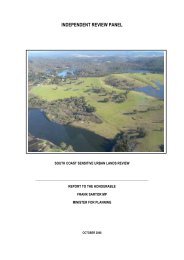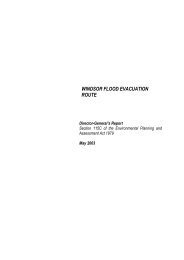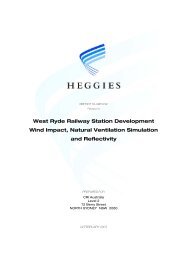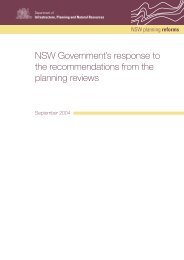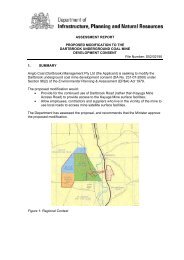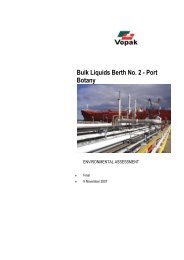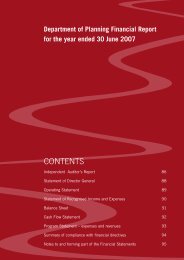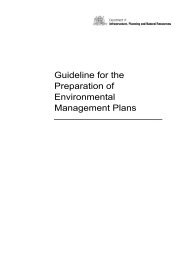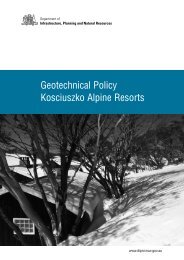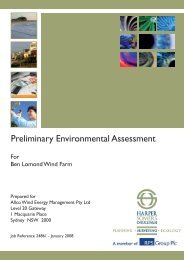Preliminary Hazard Analysis - Department of Planning
Preliminary Hazard Analysis - Department of Planning
Preliminary Hazard Analysis - Department of Planning
Create successful ePaper yourself
Turn your PDF publications into a flip-book with our unique Google optimized e-Paper software.
E N V I R O N M E N T A L A S S E S S M E N T<br />
<strong>Preliminary</strong> <strong>Hazard</strong> <strong>Analysis</strong> Chapter 18<br />
The tasks involved in the hazard identification <strong>of</strong> the proposed facility included a review <strong>of</strong> all relevant<br />
data and information to highlight specific areas <strong>of</strong> potential concern and points <strong>of</strong> discussion, including<br />
drafting up <strong>of</strong> preliminary hazard identification word diagram. The hazard identification word diagram<br />
is then reviewed and complete in a workshop which included people with operational / engineering /<br />
risk assessment expertise. The review takes into account both random and systematic errors, and<br />
gives emphasis not only to technical requirements, but also to the management <strong>of</strong> the safety activities<br />
and the competence <strong>of</strong> people involved in them.<br />
Stage 2 – Consequence and Effect <strong>Analysis</strong><br />
The consequences <strong>of</strong> identified hazards are assessed using current techniques for risk assessment.<br />
Well established and recognised correlations between exposure and effect on people are used to<br />
calculate impacts.<br />
Stage 3 – Frequency <strong>Analysis</strong><br />
For incidents with significant effects, whether on people, property or the biophysical environment, the<br />
incident frequency are estimated, based on historical data. A probabilistic approach to the failure <strong>of</strong><br />
vessels and pipes is used to develop frequency data on potentially hazardous incidents.<br />
Stage 4 – Quantitative Risk <strong>Analysis</strong><br />
The combination <strong>of</strong> the probability <strong>of</strong> an outcome, such as injury or death, combined with the<br />
frequency <strong>of</strong> an event gives the risk from the event. The risk for each incident is calculated according<br />
to:<br />
Risk = Consequence x Frequency<br />
Total risk is obtained by adding together the results from the risk calculations for each incident, i.e. the<br />
total risk is the sum <strong>of</strong> the risk calculated for each scenario.<br />
The results <strong>of</strong> the risk analysis are presented in three forms:<br />
• Individual Fatality Risk, i.e. the likelihood (or frequency) <strong>of</strong> fatality to notional individuals at<br />
locations around the site, as a result <strong>of</strong> any <strong>of</strong> the postulated fire and explosion events. The units<br />
for individual risk are probability (<strong>of</strong> fatality) per million per year. Typically, the result <strong>of</strong> individual<br />
risk calculations is shown in the form <strong>of</strong> risk contours overlaid on a map <strong>of</strong> the development area.<br />
For pipelines (as for other transport activities), the individual risk contours are best represented<br />
as risk transects, showing the risk as a function <strong>of</strong> the distance from the pipeline.<br />
• Injury and irritation risk, i.e. the likelihood <strong>of</strong> injury to individuals at locations around the site as a<br />
result <strong>of</strong> the same scenarios used to calculate individual fatality risk.<br />
• Societal risk takes into account the number <strong>of</strong> people exposed to risk. Whereas individual risk is<br />
concerned with the risk <strong>of</strong> fatality to a (notional) person at a particular location (person 'most at<br />
risk', i.e. outdoors), societal risk considers the likelihood <strong>of</strong> actual fatalities among any <strong>of</strong> the<br />
people exposed to the hazard. Societal risk are presented as so called f-N curves, showing the<br />
frequency <strong>of</strong> events (f) resulting in N or more fatalities. To determine societal risk, it is necessary<br />
to quantify the population within each zone <strong>of</strong> risk surrounding a facility. By combining the risk<br />
results with the population data, a societal risk curve can be produced.<br />
The risk results are then assessed against the guidelines adopted by the <strong>Department</strong> <strong>of</strong> <strong>Planning</strong>.<br />
Herons Creek Peaking Power Plant<br />
18-3



